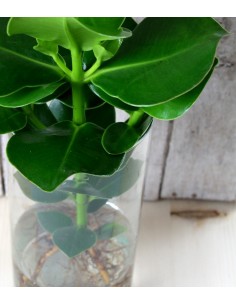- Home
- 13467 views
- 0 comments
Have you ever heard of hydroponic cultivation? We'll explain it to you! The word derives from the Greek "hydor" (water) and "pònos" (work). Essentially it is a plant growth technique out of the "classic" soil.
It is actually an ancient concept, discovered in 1930, but it has only been used in recent times in recent times. Examples of this type can be found, however, in the hanging gardens of Babylon and in the cultivations of the mountain peoples of Peru and Mianmar, which create real gardens on the surface of the water.
The purpose of this technique is to maximize the vegetative quality of the plant even if it does not have soil. The latter, when employed, performs exclusively the function of nutrient reserve and "physical" support, but it is not essential if these two tasks are performed by other growth substrates.
If in hydroculture we speak of aquatic plants - which then develop autonomously in lakes, basins, small ponds or in any case short watercourses - hydroponics treats plants that are usually grown on the ground.
Hydroponic techniques can also be found in outdoor vertical gardens, very popular in recent years, but the most common realization is that from the inside. It is a technique widely used by those who, for example, want to create the classic "home garden", or for anyone who dreams of eating with self-produced vegetables, but does not have a nursery, a greenhouse or a garden to grow them.
It can also be implemented in areas unfavorable from the climatic point of view and conducted throughout the year because under controlled conditions and often with artificial light, thus freeing itself from the seasonal needs of the species.

Generally the most suitable plants for this cultivation method are the seed or cuttings plants.
There are several kits to build a hydroponic system. The application is anything but difficult: for seed plants, for example, rock wool cubes are used well moistened with water and enriched with root solution. Expanded clay or perlite are often also used.
The basic instrumentation is usually completed by an immersion pump with tube oxygenator, resistant plastic cups, watering pipes and a timer for automatic watering.
An advantage not to be overlooked is that nutrient administration is carried out in a controlled manner, therefore without the typical wastes of fertilizers, or chemical reactions in the presence of rain or atmospheric agents, and consequently without pollution.
The water can be reused within the same hydroponic system, thus saving on irrigation costs, and the yield is high with greater force on the part of the plant and less vulnerability to diseases and pests.
In some plants, then, hydroponic cultivation is as simple as ... drinking a glass of water, just to stay on the subject! In our store you can find an example: the Clusia, a plant that in its natural habitat is located as epiphyte, ie not rooted in the ground but settled on trunks or branches of trees. Being already accustomed to such growth, it can be grown in a very simple glass container. To maintain it, simply fill the pot with water at room temperature, so that the roots remain just below the water level. To avoid unpleasant calcareous marks on the jar, you can use bottled water (obviously not sparkling) instead of tap water.
The Clusia, an unusual plant in itself thanks to the shape of the stems and leaves, will thus show its most scenographic aspect and allow you to admire the development of its roots!



Comments (0)